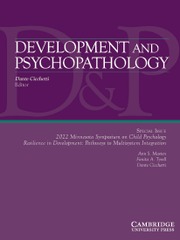Crossref Citations
This article has been cited by the following publications. This list is generated based on data provided by
Crossref.
Heinrichs, Markus
Chen, Frances S.
and
Domes, Gregor
2012.
Psychobiological Approaches for Anxiety Disorders.
p.
123.
Dackis, Melissa N.
Rogosch, Fred A.
Oshri, Assaf
and
Cicchetti, Dante
2012.
The role of limbic system irritability in linking history of childhood maltreatment and psychiatric outcomes in low-income, high-risk women: Moderation by FK506 binding protein 5 haplotype.
Development and Psychopathology,
Vol. 24,
Issue. 4,
p.
1237.
Ditzen, Beate
Bradley, Bekh
and
Heim, Christine M.
2012.
Oxytocin and Pair Bonding: On Possible Influences During the Life Course.
Biological Psychiatry,
Vol. 72,
Issue. 3,
p.
e3.
Mackenzie, Robin
and
Watts, John
2012.
Does lack of a moral feeling brain indicate moral disability? Children diagnosed with callous unemotional traits, emotion regulation and the potential of treatment with oxytocin.
Tizard Learning Disability Review,
Vol. 17,
Issue. 4,
p.
184.
Kumsta, Robert
and
Heinrichs, Markus
2013.
Oxytocin, stress and social behavior: neurogenetics of the human oxytocin system.
Current Opinion in Neurobiology,
Vol. 23,
Issue. 1,
p.
11.
Bradley, Bekh
Davis, Telsie A.
Wingo, Aliza P.
Mercer, Kristina B.
and
Ressler, Kerry J.
2013.
Family environment and adult resilience: contributions of positive parenting and the oxytocin receptor gene.
European Journal of Psychotraumatology,
Vol. 4,
Issue. 1,
van Roekel, Eeske
Verhagen, Maaike
Scholte, Ron H. J.
Kleinjan, Marloes
Goossens, Luc
Engels, Rutger C. M. E.
and
Krueger, Frank
2013.
The Oxytocin Receptor Gene (OXTR) in Relation to State Levels of Loneliness in Adolescence: Evidence for Micro-Level Gene-Environment Interactions.
PLoS ONE,
Vol. 8,
Issue. 11,
p.
e77689.
Lee Raby, K.
Cicchetti, Dante
Carlson, Elizabeth A.
Egeland, Byron
and
Andrew Collins, W.
2013.
Genetic contributions to continuity and change in attachment security: a prospective, longitudinal investigation from infancy to young adulthood.
Journal of Child Psychology and Psychiatry,
Vol. 54,
Issue. 11,
p.
1223.
Mitchell, Ian J.
Smid, Winike
Troelstra, Jelle
Wever, Edwin
Ziegler, Toni E.
and
Beech, Anthony R.
2013.
Psychopathic characteristics are related to high basal urinary oxytocin levels in male forensic patients.
Journal of Forensic Psychiatry & Psychology,
Vol. 24,
Issue. 3,
p.
309.
Westen, Drew
Waller, Niels G.
Shedler, Jonathan
and
Blagov, Pavel S.
2014.
Dimensions of Personality and Personality Pathology: Factor Structure of the Shedler–Westen Assessment Procedure-II (SWAP-II).
Journal of Personality Disorders,
Vol. 28,
Issue. 2,
p.
281.
MacDonald, Kai
and
Feifel, David
2014.
Oxytocin׳s role in anxiety: A critical appraisal.
Brain Research,
Vol. 1580,
Issue. ,
p.
22.
Cicchetti, Dante
and
Rogosch, Fred A.
2014.
Genetic moderation of child maltreatment effects on depression and internalizing symptoms by serotonin transporter linked polymorphic region (5-HTTLPR), brain-derived neurotrophic factor (BDNF), norepinephrine transporter (NET), and corticotropin releasing hormone receptor 1 (CRHR1) genes in African American children.
Development and Psychopathology,
Vol. 26,
Issue. 4pt2,
p.
1219.
Clark-Polner, Elizabeth
and
Clark, Margaret S.
2014.
Understanding and accounting for relational context is critical for social neuroscience.
Frontiers in Human Neuroscience,
Vol. 8,
Issue. ,
Chang, Shun-Chiao
Glymour, M. Maria
Rewak, Marissa
Cornelis, Marilyn C.
Walter, Stefan
Koenen, Karestan C.
Kawachi, Ichiro
Liang, Liming
Tchetgen Tchetgen, Eric J.
and
Kubzansky, Laura D.
2014.
Are genetic variations in OXTR, AVPR1A, and CD38 genes important to social integration? Results from two large U.S. cohorts.
Psychoneuroendocrinology,
Vol. 39,
Issue. ,
p.
257.
Connelly, Jessica J.
Golding, Jean
Gregory, Steven P.
Ring, Susan M.
Davis, John M.
Davey Smith, George
Harris, James C.
Carter, C. Sue
Pembrey, Marcus
and
Dowd, Jennifer Beam
2014.
Personality, Behavior and Environmental Features Associated with OXTR Genetic Variants in British Mothers.
PLoS ONE,
Vol. 9,
Issue. 3,
p.
e90465.
Loth, Eva
Poline, Jean-Baptiste
Thyreau, Benjamin
Jia, Tianye
Tao, Chenyang
Lourdusamy, Anbarasu
Stacey, David
Cattrell, Anna
Desrivières, Sylvane
Ruggeri, Barbara
Fritsch, Virgile
Banaschewski, Tobias
Barker, Gareth J.
Bokde, Arun L.W.
Büchel, Christian
Carvalho, Fabiana M.
Conrod, Patricia J.
Fauth-Buehler, Mira
Flor, Herta
Gallinat, Jürgen
Garavan, Hugh
Heinz, Andreas
Bruehl, Ruediger
Lawrence, Claire
Mann, Karl
Martinot, Jean-Luc
Nees, Frauke
Paus, Tomáš
Pausova, Zdenka
Poustka, Luise
Rietschel, Marcella
Smolka, Michael
Struve, Maren
Feng, Jianfeng
and
Schumann, Gunter
2014.
Oxytocin Receptor Genotype Modulates Ventral Striatal Activity to Social Cues and Response to Stressful Life Events.
Biological Psychiatry,
Vol. 76,
Issue. 5,
p.
367.
Mohiyeddini, Changiz
Opacka-Juffry, Jolanta
and
Gross, James J.
2014.
Emotional suppression explains the link between early life stress and plasma oxytocin.
Anxiety, Stress, & Coping,
Vol. 27,
Issue. 4,
p.
466.
Dunn, Erin C.
Solovieff, Nadia
Lowe, Sarah R.
Gallagher, Patience J.
Chaponis, Jonathan
Rosand, Jonathan
Koenen, Karestan C.
Waters, Mary C.
Rhodes, Jean E.
and
Smoller, Jordan W.
2014.
Interaction between genetic variants and exposure to Hurricane Katrina on post-traumatic stress and post-traumatic growth: A prospective analysis of low income adults.
Journal of Affective Disorders,
Vol. 152-154,
Issue. ,
p.
243.
McQuaid, Robyn J.
McInnis, Opal A.
Abizaid, Alfonso
and
Anisman, Hymie
2014.
Making room for oxytocin in understanding depression.
Neuroscience & Biobehavioral Reviews,
Vol. 45,
Issue. ,
p.
305.
Chang, Wei Hung
Lee, I Hui
Chen, Kao Chin
Chi, Mei Hung
Chiu, Nan-Tsing
Yao, Wei Jen
Lu, Ru-Band
Yang, Yen Kuang
and
Chen, Po See
2014.
Oxytocin receptor gene rs53576 polymorphism modulates oxytocin–dopamine interaction and neuroticism traits—A SPECT study.
Psychoneuroendocrinology,
Vol. 47,
Issue. ,
p.
212.


